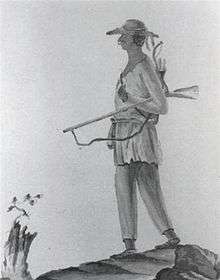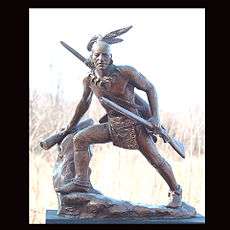Daniel Nimham
Daniel Nimham (also Ninham) (1726–1778) was the last sachem of the Wappinger. He was the most prominent Native American of his time in the lower Hudson Valley.
Background
Prior to Henry Hudson's arrival in 1609, the Wappinger People lived on the eastern shore of the today's Hudson River, a tidal estuary for some half its length. To them, it was the Muhheakantuck, "the river that flows both ways", and their territory spread from Manhattan Island north to the Roeliff Jansen Kill in Columbia County, and east as far as the Norwalk River Fairfield County, Connecticut. The Wappinger were allied with the Mohican People to the north. Their settlements included camps along the major creeks and Hudson River tributaries with larger villages located where these streams met the river.
During the early period of European contact, the population of the Wappingers has been estimated at approximately 600.[1] They are said to have occupied the highlands north of Anthony's Nose to Matteawan Creek (today's Fishkill Creek). Adriaen van der Donck, one of the earliest writers of this portion of the country, assigns them three villages on the Hudson; Keskistkonck, Pasquasheck and Nochpeems; but their principal village was Canopus, which was situated in a valley in Putnam county, and known as Canopus Hollow.[2] To the Dutch and English they were known as the "River Indians" and the "Highland Indians".
History
Robert S. Grumet describes Daniel Nimham as the "leader of a small peripatetic group of from two hundred to three hundred displaced Mahican- and Munsee-speaking Indian people" who wandered the "mountainous contested borderlands separating Massachusetts, Connecticut, New York, New Jersey, and Pennsylvania.[3] They built small bark houses and log cabins on sparsely settled lands in remote valleys far from colonial roads and towns, and made meager livings weaving baskets, crafting brooms and working seasonal as laborers or servants on nearby farms.
He learned to speak English by listening to his new neighbors.
After 1746 his residence was at Westenhuck, near Great Barrington, Massachusetts. In 1755, during King George's War, he, with most of his fighting men, traveled to Albany and entered the English service under Sir William Johnson,[4] By March 1758, he was in Stockbridge, Massachusetts, serving as town constable, although it appears he continued to frequent the ancestral lands around Wiccopee in Dutchess County, New York.[3]
Land claims
In 1697, Adolphus Philipse, a wealthy New York City merchant and son of the first lord of Philipsburg Manor purchased land from two Dutch squatters, Jan Sybrandt (Seberinge) and Lambert Dorlandt. As they had never had a patent, Philips subsequently negotiated a confirmation deed with local representatives of the remaining Wappinger in which they renounced title to the land. Philipse claimed the deed set the Connecticut line as the patent's eastern border.[1]
During the French and Indian War, the Wappingers or "Indians of the long reach" as that section of the river was called, furnished a corps of about three hundred,[2] notably, to serve with Rogers' Rangers. They had moved their families to the Christian Indian mission settlement at Stockbridge, for the duration of the war. When the men returned, they found their land rented by the Philipses to tenant farmers.
Daniel Ninham may have learned to speak English through the family of Catheryna Rombout Brett who lived in what is now the City of Beacon, New York. She was friends with the Ninhams and allowed the Wappinger to stay on her land after it had been sold. Most historians suggest Daniel Nimham was born in the Fishkill Creek Region near the hamlet of Wiccopee, New York. Because of Ninham's multicultural skills, he went to court on several occasions to defend his people's land rights.
Nimham contested the validity of the Philipse's deed arguing with considerable justification that the Wappinger had been defrauded of their lands.[5] The New York Council, dominated by manor lords, threw out Nimham's claim and jailed his legal advisor, Samuel Munrow, for "high misdemeanors".[6] Undeterred, In 1766, Nimham and three Mohican chiefs: Jacob Cheeksaunkun, John Naunauphtaunk and Solomon Uhhaunauwaunmut from the Stockbridge area and three of their wives traveled to England to present his case to the royal Lords of Trade. The trip was financed largely by a combination of sympathetic rent rioters and land speculators.[3] The London Chronicle describes the Nimham group of four chiefs as tall and strong, one being "six and a half feet without shoes...dressed in the Indian manner." Although he and his group were treated very well, he never had a meeting with the King directly (unlike the Four Mohawk Kings of half a century earlier), however he did speak with someone who was in the parliament who agreed to contact the governor in Albany, New York.
The Lords of Trade reported that there was sufficient cause to investigate "frauds and abuses of Indian lands...complained of in the American colonies, and in this colony in particular." And that, "the conduct of the lieutenant-governor and the council...does carry with it the colour of great prejudice and partiality, and of an intention to intimidate these Indians from prosecuting their claims."[6] Upon a second hearing before New York Provincial Governor Sir Henry Moore and the Council, John Morin Scott argued that legal title to the land was only a secondary concern. Returning the land to the Indians would set an adverse precedent regarding other similar disputes.[7]
Stockbridge Militia

Daniel's son Abraham Nimham (born in 1745) was appointed captain of a company of Indian scouts serving with the Continental Army, a confederacy of Mohicans, Wappingers, Munsee and other local tribes.Stockbridge Militia by General George Washington.
Daniel and Abraham Nimham and his fellow Stockbridge warriors fought for the American cause during the Revolution and were some of America's first Veterans. They served with Washington at Valley Forge and later with General Marquis de Lafayette's troops. It is noted that Daniel "faithfully served in the army as a soldier at Cambridge...In 1775 ".
On August 31, 1778, the Nimhams and fifty of their fellow Wappinger were surrounded then killed by Loyalist, British Dragoons and Hessian Soldiers under the command of Lt. Colonel John Graves Simcoe in the Battle of Kingsbridge Cortlandt Ridge in what is now Van Cortlandt Park in the Bronx. A stone monument to the Stockbridge Warriors who sacrificed their lives for the American cause marks a trail to the battlefield.
Mohican Sachem Hendrick Aupaumut and others of the tribe petitioned the General Court for compensation for the losses at the Bronx Massacre, dated September 22, 1778. "Our young men have been employed in the present War against the common Enemy and many have lately fell in Battle. Their Widows are now left to care of themselves and their children; without help from their husbands, who at this season of the year provided for their families by hunting. We Indians depend on hunting to clothe ourselves and families. But when we get skins we know not where to go to trade for clothing. We are not able to make any ourselves. Our way of living is very different from our English breathren. And by this, we the subscribers, in behalf of our Tribe now earnestly pray you to consider our circumstances, and open your hearts, by providing such way by which we may be able to procure some coarse cloathing particularly Blankets." [8]
By the early 1800s many of the local native people from Stockbridge had joined the Oneida Nation in New York, eventually journeying west to Ontario and Wisconsin.
Legacy
- In 1906, the Mount Vernon, New York Chapter of the Daughters of the American Revolution dedicated the Chief Nimham Memorial at Van Cortlandt Park in the Bronx, New York.[9]
- Ninham Mountain, which rises to 1,260' in the town of Kent, Putnam County, New York, of NYS Route 41 is named after him.
- Lake Ninham in the town of Kent is named after him.
- The Ninham Mountain Fire Tower, an 83' tall historic steel tower atop Ninham Mountain is named after him.
- A marker on Gypsy Trail Road at the entrance to the park reads "Named in honor of the Sachem Daniel Nimham of Wappinger Indians killed in 1778 while fighting at Kings Bridge with our American Forces" and is dated 1932.
- In 1932, the New York State Education Department erected an historical marker in Kent on Route 301 to commemorate Nimham.(41° 28.312′ N, 73° 45.612′ W.) A second marker was erected in 1937 at the intersection of State Route 52 and 82 in Fishkill.(41° 32.685′ N, 73° 52.16′ W.)
- New York State's Ninham Mountain Multiple Use Area was established in the town of Kent. The 1,054-acre property has an extensive network of trails and old roads and is popular with bikers, hikers and horseback riders.
- Since 2001 the Annual Daniel Nimham Intertribal Pow Wow has been held in Putnam County in his honor. Members of tribes from all over the Northeast attend, and engage in intertribal dancing and other rituals. The event is open to the public.[10]

- Area sculptor Michael Keropian has produced a small scale bronze sculpture of sachem Nimham in period tribal costume, part of a larger effort to get a full-sized memorial to Nimham in an appropriate location in the Hudson Valley.
References
- "Boesch, Eugene J., "Daniel Nimham and the Wappingers", Native Americans Of Putnam County, Mahopac Library, Local History" (PDF). Archived from the original (PDF) on 2015-01-13. Retrieved 2015-01-13.
- Pelletreau, William S., History of Putnam County, New York, W.W. Preston & Co., Philadelphia, 1886, pgs 66-86
- Grumet, Robert S. "The Nimhams of the Colonial Hudson Valley 1667-1783", The Hudson River Valley Review, The Hudson River Valley Institute
- Handbook of American Indians North of Mexico, Vol.3, Smithsonian Institution Bureau of American Ethnology, 1912
- "Putnam's Origins", PutnamCountyOnline
- Nash, Gary B., "The Unknown American Revolution", Penguin, 2006 ISBN 9781440627057
- Smolenski, John. and Humphrey, Thomas J., New World Orders: Violence, Sanction, and Authority in the Colonial Americas, University of Pennsylvania Press, 2013 ISBN 9780812290004
- Frazier, Patrick (1992). The Mohicans of Stockbridge. University of Nebraska Press. ISBN 0-8032-6882-3.
- "Chief Ninham Memorial", New York City Department of Parks & Recreation
- Vitelli, Andrew. "Nimham Memorial Recognizes War Hero", Putnam Examiner, August 21, 2013
Further reading
- Grumet, Robert S. "The Nimhams of the Colonial Hudson Valley 1667-1783", The Hudson River Valley Review
- Vaughn, Alden. Transatlantic Encounters: American Indians in Britain, 1500-1776, Cambridge University Press, ISBN 0-521-86594-8